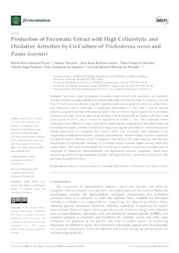Production of enzymatic extract with high cellulolytic and oxidative activities by co-culture of Trichoderma reesei and Panus lecomtei.
Production of enzymatic extract with high cellulolytic and oxidative activities by co-culture of Trichoderma reesei and Panus lecomtei.
Autoria: ROMERO PELÁEZ, R. D.; WISCHRAL, D.; CUNHA, J. R. B.; MENDES, T. D.; PACHECO, T. F.; SIQUEIRA, F. G. de; ALMEIDA, J. R. M. de
Resumo: This work aimed to produce enzymatic fungi extracts with hydrolytic and oxidative activities to hydrolyze lignocellulosic biomasses efficiently. For this, the fungi Trichoderma reesei and Panus lecomtei were co-cultured using the vegetable biomasses oil palm decanter cake, wheat bran, and cottonseed cake as substrates in submerged fermentation. T. reesei and P. lecomtei showed partially compatible positive interaction on plates. The co-cultures respond positively to variations of temperature and inoculum interval, generating extracts responsible for higher hydrolysis yield when grown at 25 °C, and P. lecomtei is inoculated 24 h after T. reesei. The enzymatic extract production of co-cultures was also improved by modifying the components of the initial media and evaluating enzymatic activities, hydrolysis of sugarcane bagasse pretreated by autohydrolysis and ethanol production as a response. Five culture media were evaluated with variations in the composition of nutritional elements, minerals and substrates. The best extract showed a maximum cellulose hydrolysis efficiency of 68.7% compared with 44.8% of the initial medium. The ethanolic fermentation of hydrolysates obtained by co-culture extracts showed higher ethanol yields than monocultures. This work demonstrates the use of fungi co-cultures to produce enzymatic extracts composed of cellulolytic, hemicellulolytic, and ligninolytic enzymes complexes, which allow hydrolyzing pretreated lignocellulosic biomass with high efficiency, generating hydrolysates that are easier fermented by yeast.
Ano de publicação: 2022
Tipo de publicação: Artigo de periódico
Unidade: Embrapa Agroenergia
Palavras-chave: Cellulases, Co-cultures, Ethanolic fermentation, Laccases, Panus lecomtei, Trichoderma reesei
Observações
1 - Por padrão são exibidas publicações dos últimos 20 anos. Para encontrar publicações mais antigas, configure o filtro ano de publicação, colocando o ano a partir do qual você deseja encontrar publicações. O filtro está na coluna da esquerda na busca acima.
2 - Para ler algumas publicações da Embrapa (apenas as que estão em formato ePub), é necessário ter, no celular ou computador, um desses softwares gratuitos. Sistemas Android: Google Play Livros; IOS: iBooks; Windows e Linux: software Calibre.
Acesse outras publicações
Acesse a Base de Dados da Pesquisa Agropecuária (BDPA) para consultar o acervo completo das bibliotecas da Embrapa.

